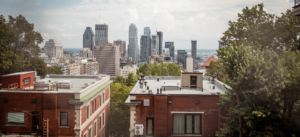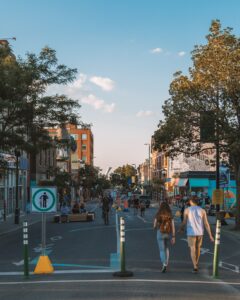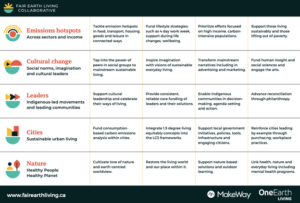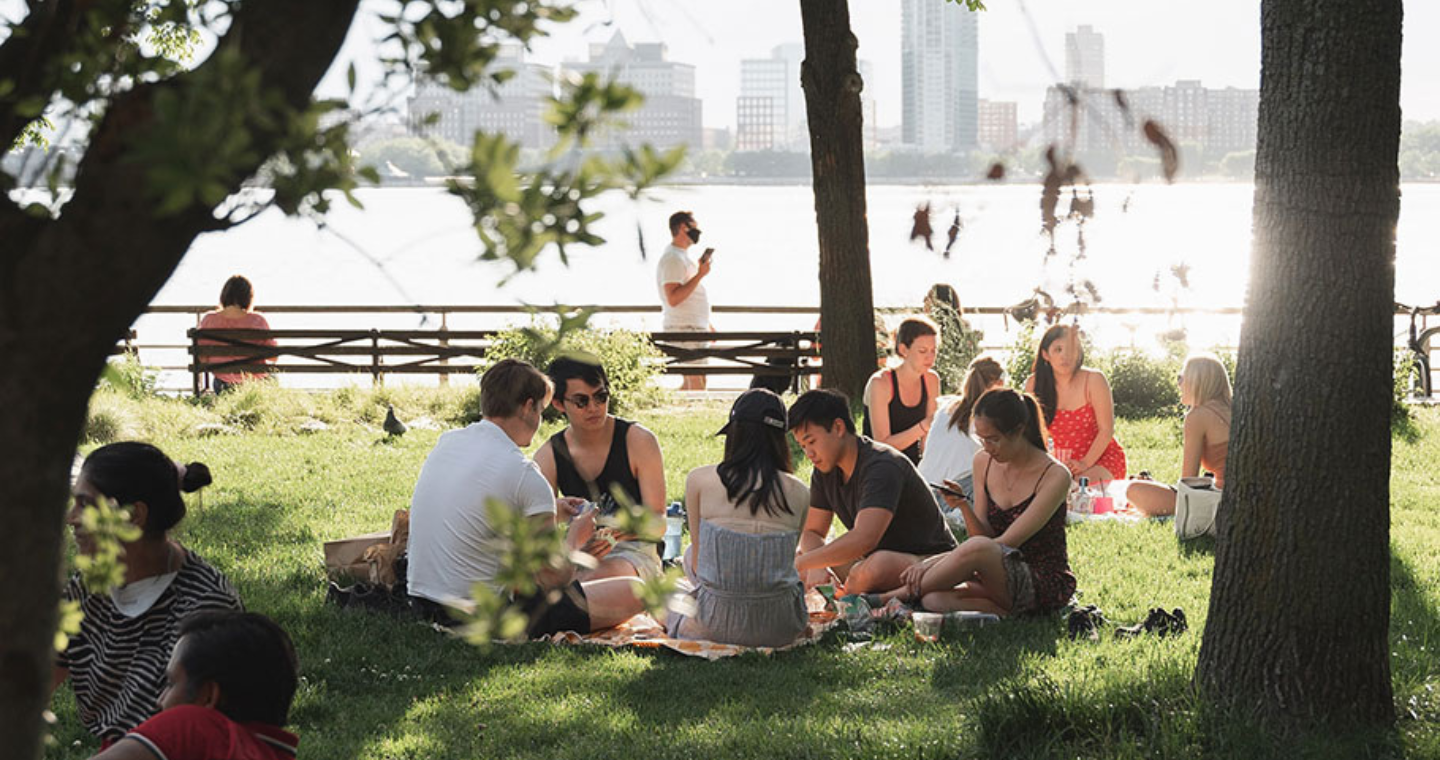What if climate action could be joyful? What if it focused on abundance instead of scarcity, on embracing fairness and new lifestyles instead of grief? These are the fundamental principles behind the Fair Earth Living Collaborative.
Canada has just experienced an unprecedented wildfire season, resulting in widespread devastation across the country. Climate breakdown is causing immense grief, suffering, dread, and anxiety. It’s important to sit with these heavy emotions, but we must remember that our collective response to the climate and biodiversity crises doesn’t need to feel like deprivation or loss.
Around the world, people and communities are responding creatively to the climate and biodiversity crises. From remote communities to dense urban neighbourhoods, there is currently a groundswell of people coming together to promote sustainable and equitable living.
Complemented by action from governments and businesses, tackling our ways of living is a necessary and significant part of addressing the current crises. Household consumption is associated with a surprising amount of greenhouse gas emissions (up to 72%, according to one study). Community-level culture and behaviour change solutions hold particular importance in Canada, where individuals have some of the largest per capita footprints globally.

Despite their potential for reducing greenhouse gas emissions, these solutions have not received as much focus by philanthropy. In 2019, when Joanna Kerr became CEO of MakeWay, she noticed this gap not only existed within MakeWay’s grantmaking priorities, but also across the broader funding sector as a whole. “There is a huge push to advance the policy and technical changes required to transition to a green, clean economy, but we also have to support those who are committed to new ways of living with each other and nature,” Joanna explains.
In 2020, Joanna met Vanessa Timmer, Executive Director of OneEarth Living–a Canadian organization advancing sustainable everyday living around the world. The two realized they shared similar visions. One call turned into many more and soon MakeWay and OneEarth Living launched a partnership. Together, the organizations created fairearthliving.ca, a digital resource that lays out what funders can do to support lifestyle and behaviour change solutions to address the climate crisis. MakeWay and One Earth Living are also co-hosting the Fair Earth Living Collaborative to help more funders see the opportunities for new ways of living.
Supporting Fair Earth Living
A nascent initiative, the Fair Earth Living Collaborative aims to support community-led climate solutions and sustainable ways of living that are accessible and affordable to everyone. It emphasizes a culture shift that supports behavior change at the personal, household, and community levels. Many communities worldwide are already practicing sustainable living, and the Fair Earth Living Collaborative provides the resources to nurture their efforts.
It’s crucial to note that the climate crisis is a story of inequality. The richest 10% of the world’s population are responsible for nearly half of global emissions, yet vulnerable communities often face the worst impacts. Fair Earth Living emphasizes the need for solutions that are accessible and affordable to everyone.

Where and how we live have huge impacts on what actions we can take; the solutions that work for rural and remote communities differ significantly from strategies for major urban areas. “It is not about placing the burden on individuals,” Vanessa notes. “This is about how we as a society create a context that supports sustainable living.” Within cities, various social, economic, and environmental factors shape the actions that individuals can take. And these actions don’t occur in a void—they are influenced by the larger context within which we live.
Examples of Fair Earth Living
While Fair Earth Living takes many forms, there are inspiring examples all around. Sacred Earth Solar (SES) is an Indigenous women-led organization that works in solidarity with impacted Indigenous communities by bringing climate solutions and healing justice initiatives directly to the frontlines of land protection, cultural resurgence, and language revitalization. The Share Reuse Repair Initiative engages communities, businesses, and governments to create a vibrant culture and economy of sharing, reuse, and repair that all Canadians can embrace in their daily lives and livelihoods, serving as a meaningful waste and climate solution. Community Resilience to Extreme Weather (CREW) is preparing Toronto residents for extreme weather, grounding their work in research highlighting the significance of social capital before, during, and after extreme weather events. These projects illustrate the diversity of initiatives that embody Fair Earth Living.
Moving beyond polarization and fear
Supporting people and communities to inspire behaviour and culture change at a systems level requires a deep understanding of people’s values and motivations. “If you want to work on culture and behaviour change, you actually have to understand where people are at, how they see the world, and what drives them,” Joanna says. OneEarth Living is exploring these motivations through insight studies in BC, Guelph, and Québec. This spring, Fair Earth Living Collaborative engaged Gail Hochachka, a social scientist at the University of British Columbia studying how people perceive and experience climate change.
“If you want to want to work on culture and behaviour change, you actually have to understand where people are at and how they see the world and what drives them.”
Academic research often overlooks the human dimensions of climate change, despite their critical role in advancing climate change policy. “Innovations in technology to meet the climate crisis can be so far ahead, and yet when we try and bring them into our home, communities, or province, the context isn’t prepared,” Gail says. The success of climate policies hinges on individual people understanding and supporting them.
Through her partnership with the Fair Earth Living Collaborative, Gail is investigating how beliefs and values influence attitudes toward climate change. She highlights that many people hesitate to participate in climate action due to uncertainty and fear surrounding an unfamiliar and potentially challenging future. “Net zero policies mean to many people that life will get more expensive and difficult,” she says.
Rather than dismissing or ridiculing concerns about climate action, Gail emphasizes that we have to try to appreciate what people are feeling. “We have to understand what is driving this polarization and work at a deeper level, in a more relational way,” Gail says. “The answer to people who are questioning climate science is not to talk more loudly about climate science—rather, it is to listen. To find out what is most meaningful to people in the context of their daily lives, so to better be able to connect climate solutions with those realities.”
“The answer to people who are questioning climate science is not to talk more loudly about climate science—rather, it is to listen. To find out what is most meaningful to people in the context of their daily lives, so to better be able to connect climate solutions with those realities.”
Joyful work for the planet
Responding to the climate and biodiversity crises requires a collective effort and sustainable ways of living that are accessible and affordable for all. Fair Earth Living seeks to shift the narrative surrounding climate change from fear and deprivation to one of joy and fulfillment. “People are seeing the climate crisis as something that is fear-based, guilt-ridden, or all about deprivation. So much joy comes from how we live our lives together,” Joanna says. Vanessa agrees, “Let’s ignite our imagination of what is possible and spread alternatives that allow us to thrive in balance with nature.”

“People are seeing the climate crisis as something that is fear-based, guilt-ridden or all about deprivation. So much joy comes from how we live our lives together.”
Close to 70 funders have engaged with the Fair Earth Living Collaborative, and 20 are coming together regularly to share learnings. The Collaborative plans to create a fund to unlock resources for organizations and projects that help people eat, play, consume, work, dwell, and move in ways that support climate action and healthy communities. “We have to support communities to advance culture and behaviour change,” Joanna reflects. “That is going to create communities of Fair Earth Living.”
In 2022, Kate O’Connor, a summer student at MakeWay, wrote a moving personal reflection on the importance of the Fair Earth Living approach. You can read her reflection here.
If you are a funder curious about supporting more sustainable and equitable living, please contact MakeWay and OneEarth Living to learn how you can get involved and embrace Fair Earth Living.
